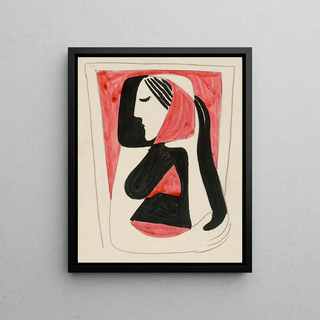Art print | This one - Mikuláš Galanda


View from behind

Frame (optional)
In the vast panorama of art history, some works stand out for their ability to capture the very essence of humanity. "Celui-ci - Mikuláš Galanda" is part of this tradition, offering a profound reflection on the human condition and the nuances of existence. Immersing oneself in this piece, the viewer is invited to explore universal themes such as identity, memory, and the search for meaning. Galanda, with his technical mastery and keen sense of observation, manages to create a dialogue between the visible and the invisible, between the tangible and the intangible.
Style and uniqueness of the work
Mikuláš Galanda's style is characterized by a figurative approach that transcends mere realism. In "Celui-ci," forms unfold with striking fluidity, while colors, subtly nuanced, evoke an atmosphere that is both intimate and universal. The work stands out through its bold use of light and shadow, which confers unprecedented depth to the depicted characters. Every detail seems loaded with meaning, inviting the viewer to prolonged contemplation. The composition, carefully orchestrated, guides the eye and creates a dynamic that engages the observer in an immersive experience. Galanda succeeds in transcending the traditional frame of painting, offering a vision that resonates with timeless modernity.
The artist and his influence
Mikuláš Galanda is an emblematic figure of Slovak art, recognized for his ability to fuse tradition and innovation. His work is marked by deep introspection, reflecting his personal and artistic journey. Trained in a context where art was often subject to constraints, Galanda learned to break free from established norms to explore uncharted territories. His influence extends well beyond Slovak borders, inspiring many contemporary artists around the world. By reinterpreting classical motifs through the lens of his unique experience, he has helped redefine the contours of modern art. The depth of his vision and the richness of his visual language continue to question and inspire, making him an essential pillar in the artistic landscape.

Matte finish

View from behind

Frame (optional)
In the vast panorama of art history, some works stand out for their ability to capture the very essence of humanity. "Celui-ci - Mikuláš Galanda" is part of this tradition, offering a profound reflection on the human condition and the nuances of existence. Immersing oneself in this piece, the viewer is invited to explore universal themes such as identity, memory, and the search for meaning. Galanda, with his technical mastery and keen sense of observation, manages to create a dialogue between the visible and the invisible, between the tangible and the intangible.
Style and uniqueness of the work
Mikuláš Galanda's style is characterized by a figurative approach that transcends mere realism. In "Celui-ci," forms unfold with striking fluidity, while colors, subtly nuanced, evoke an atmosphere that is both intimate and universal. The work stands out through its bold use of light and shadow, which confers unprecedented depth to the depicted characters. Every detail seems loaded with meaning, inviting the viewer to prolonged contemplation. The composition, carefully orchestrated, guides the eye and creates a dynamic that engages the observer in an immersive experience. Galanda succeeds in transcending the traditional frame of painting, offering a vision that resonates with timeless modernity.
The artist and his influence
Mikuláš Galanda is an emblematic figure of Slovak art, recognized for his ability to fuse tradition and innovation. His work is marked by deep introspection, reflecting his personal and artistic journey. Trained in a context where art was often subject to constraints, Galanda learned to break free from established norms to explore uncharted territories. His influence extends well beyond Slovak borders, inspiring many contemporary artists around the world. By reinterpreting classical motifs through the lens of his unique experience, he has helped redefine the contours of modern art. The depth of his vision and the richness of his visual language continue to question and inspire, making him an essential pillar in the artistic landscape.






